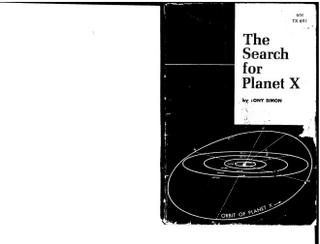Childhood Artifacts
Once my friend Zack and I were discussing childhood artifacts. That's what we named them. Sometimes toys but they don't have to be; those relics from long ago that occupied a part of our lives and now live on as echoes, talismans from another age. We stare at them, worn from years of attention. Battle scarred by our affection.
For my friend Zack, it was a Boy Scout cooking gear set. The panhandle unscrews, reverses and unites with a nifty metal plate to hold the entire operation snug like a metal turtle.
For me, after much thought and some not insubstantial poking around old boxes like plumbing the depths of archealogical sites, I think it's The Search for Planet X.
This book, published in 1962 (look at the price!)--is essentially the story of Pluto's discovery. However, the book begins with Copernicus and recounts the history of those after him: Kepler, Galileo, Newton--guys now so well known they go by one name. It spans the first use of a telescope outside Florence, Italy by Galileo to Percival Lowell (of the Lowell, Massachusetts clan) "seeing" canals on Mars from a hilltop outside Flagstaff, Arizona. Heady stuff full of diagrams and pictures and formulas such as that for the Force of Gravity [G(m1 X m2)/d2 if you're interested].
Then it shifts to the story of hard-working Kansas farmboy Clyde Tombaugh who gets the astronomy bug, builds telescopes, starts observing and eventually gets invited to work at Lowell Observatory based on the strength of his handrawn pictures of Jupiter, Saturn, Mars and the moon. He discovers Pluto in 1930 using a blink microscope--comparing pictures of the sky manually and seeing which objects move. I went to Lowell Observatory a few years ago and saw the actual plates which showed the movement. I felt like I was in a temple.
Galileo drew marvelously delicate pictures of the moon too. That was back when science and art were close cousins.
For my friend Zack, it was a Boy Scout cooking gear set. The panhandle unscrews, reverses and unites with a nifty metal plate to hold the entire operation snug like a metal turtle.
For me, after much thought and some not insubstantial poking around old boxes like plumbing the depths of archealogical sites, I think it's The Search for Planet X.
This book, published in 1962 (look at the price!)--is essentially the story of Pluto's discovery. However, the book begins with Copernicus and recounts the history of those after him: Kepler, Galileo, Newton--guys now so well known they go by one name. It spans the first use of a telescope outside Florence, Italy by Galileo to Percival Lowell (of the Lowell, Massachusetts clan) "seeing" canals on Mars from a hilltop outside Flagstaff, Arizona. Heady stuff full of diagrams and pictures and formulas such as that for the Force of Gravity [G(m1 X m2)/d2 if you're interested].
Then it shifts to the story of hard-working Kansas farmboy Clyde Tombaugh who gets the astronomy bug, builds telescopes, starts observing and eventually gets invited to work at Lowell Observatory based on the strength of his handrawn pictures of Jupiter, Saturn, Mars and the moon. He discovers Pluto in 1930 using a blink microscope--comparing pictures of the sky manually and seeing which objects move. I went to Lowell Observatory a few years ago and saw the actual plates which showed the movement. I felt like I was in a temple.
Galileo drew marvelously delicate pictures of the moon too. That was back when science and art were close cousins.



0 Comments:
Post a Comment
<< Home